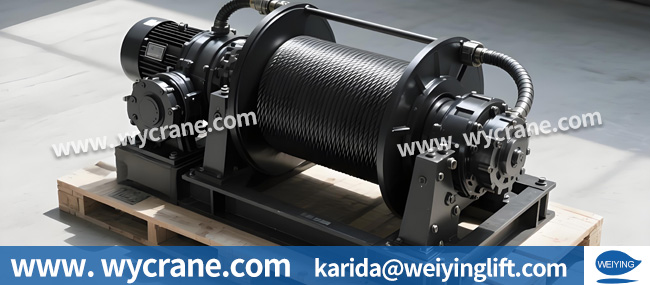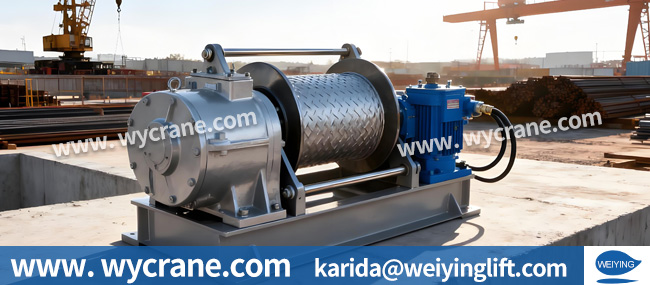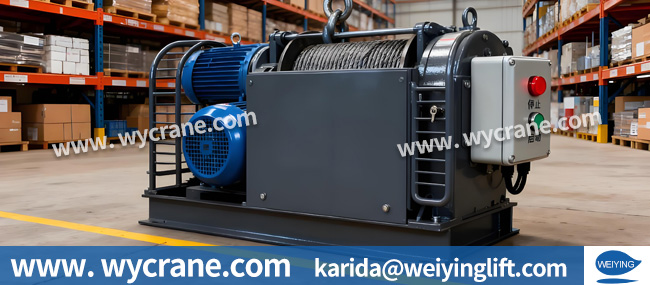In industrial and engineering sectors, winches serve as critical lifting and traction equipment, whose performance directly impacts operational efficiency, safety, and operating costs. Hydraulic and electric drives, as two mainstream technical routes, each have distinct characteristics and applicable scenarios. Choosing between them is not a matter of pursuing so-called “more advanced technology” but rather making a systematic decision based on actual working conditions, load requirements, and environmental factors.
Hydraulic winches rely on a hydraulic system to transmit power. Typically driven by an engine or electric motor, a hydraulic pump converts mechanical energy into the pressure energy of hydraulic oil. The flow and pressure are regulated through control valves to drive the hydraulic motor, which outputs high torque and ultimately powers the drum. Their core advantages lie in smooth power transmission and strong overload capacity, making them particularly suitable for heavy-duty, low-speed, and continuous operation conditions.
Electric winches use an electric motor as the direct power source. The motor’s speed and torque are adjusted through an electrical control system (such as a frequency converter or contactor), amplified by a gear reducer, and then drive the drum. The advantages of electric systems are reflected in their fast response speed, high control precision, and high energy conversion efficiency, making them suitable for medium-to-light loads, high-frequency start-stop operations, or scenarios requiring precise positioning.

Hydraulic winches excel in heavy-duty applications, typically sustaining loads above 10 tons, with maximum traction force reaching 500 kN or even higher. By setting the maximum working pressure through relief valves, they inherently possess overload protection capabilities. Even with sudden load changes of up to 20%, they can maintain stable operation without causing system damage. For example, in scenarios like mine shaft hoisting or port container handling, hydraulic winches are the preferred choice due to their high torque and stability.
Electric winches are more suitable for medium-to-light load operations (typically below 15 tons). Their load capacity is limited by the motor’s rated power and heat dissipation conditions. Prolonged overload operation can easily trigger overheating protection, leading to operational interruptions. However, within the rated load, electric winches can provide efficient and frequent start-stop operations.
Electric winches generally outperform in control precision. Through frequency conversion control, the motor can accurately adjust speed within a range of 0-1500 rpm. Coupled with high-precision sensors, positioning accuracy within ±2 mm can be achieved, making them highly suitable for applications requiring high precision, such as construction tower cranes or production line material handling.
Hydraulic winches can also adjust speed via proportional valves, but their response speed is relatively slower, and their fine-tuning performance is not as good as electric systems. Slight pressure fluctuations may also occur during low-speed operation.

The operational environment is a key consideration in the selection decision, directly affecting equipment reliability and lifespan.
Hydraulic winches are renowned as “performers in harsh environments.” Their enclosed structure effectively resists erosion from dust, moisture, and salt spray. Simply by changing the hydraulic oil to the appropriate viscosity, they can operate stably in extremely cold environments as low as -30°C or high-temperature workshops above 50°C. In environments with high dust, moisture, or strong corrosiveness, such as offshore oil platforms or underground mines, the mean time between failures (MTBF) for hydraulic winches typically far exceeds that of electric winches.
Electric winches have higher requirements for the working environment. Motors, cable connectors, and electrical components are prone to failure in damp (humidity >85%), dusty, or corrosive atmospheres. Additional measures such as housings with IP65 or higher protection ratings and sealing are required, which increases costs. Therefore, they are more suitable for dry, clean, and temperature-stable indoor environments, such as food processing or electronics manufacturing workshops.
When selecting a winch, don’t just look at the purchase price; instead, comprehensively evaluate its total cost of ownership (TCO) over its lifecycle.
Electric winches have a relatively simple structure, and their procurement cost is typically 30%-40% lower than hydraulic winches of the same specification.
Hydraulic winches involve complex systems including hydraulic pumps, valve blocks, oil tanks, and piping, resulting in higher initial acquisition costs.
Electric winches have higher energy efficiency, converting electrical energy directly into mechanical energy with minimal losses. However, their maintenance costs exhibit periodic peaks: motor brushes need replacement every 3-6 months, frequency converters may need replacement after about 3 years under high-frequency use, and traction cables require regular wear inspection.
Hydraulic winches, although less energy-efficient due to losses in hydraulic transmission, have lower long-term maintenance costs. The main maintenance tasks involve regular replacement of hydraulic oil, filters, and inspection of seals.

Both comply with strict safety standards, but they achieve safety through different paths.
Hydraulic winches possess passive safety advantages. Their core is the pressure-loss protection function: in the event of unexpected power failure or pipeline rupture, the hydraulic lock can instantly lock the actuator, preventing load falling. Additionally, the system pressure is limited by relief valves, avoiding damage to mechanical structures due to overload.
Electric winches rely on active safety systems. Through electromagnetic brakes, overload relays, weight sensors, etc., they actively cut off power and apply brakes upon detecting overload, power failure, or abnormalities. Their braking response is rapid (can act within 0.5 seconds), but there is a risk of false triggering during grid voltage fluctuations.
Define Core Operational Parameters:
Determine the maximum load/traction force, lifting height/speed, and daily operational frequency. Choose hydraulic for heavy-duty continuous operations; choose electric for medium-to-light loads with high-frequency start-stop.
Assess the Operational Environment:
Check the environment’s temperature range, humidity, dust concentration, and presence of corrosive substances. Prefer hydraulic for extreme and harsh environments; electric is more economical for clean and stable environments.
Calculate Lifecycle Cost:
Develop a 5-year total cost model incorporating equipment procurement, installation, energy consumption, expected maintenance costs, and potential downtime losses. For long-term heavy-duty projects, hydraulic TCO is lower; for short-term or light-duty projects, electric is more cost-effective.
Reference Industry Practices and Certifications:
Hydraulic winches dominate in fields like mining, ports, and marine engineering. Electric winches are more widely used in construction, manufacturing workshop logistics. Prioritize products certified by international standards like ISO, API, CE, and consult feedback from users in similar industries.
The choice between a hydraulic winch and an electric winch is a precise trade-off among power, environment, cost, and safety. There is no absolute winner, only the solution most suitable for specific working conditions.
Choose a hydraulic winch if you prioritize: Ultimate heavy-duty capability, ultra-high reliability in harsh environments, and better long-term operational economy.
Choose an electric winch if you value: Precise motion control, higher energy efficiency, lower initial investment, and operate in a clean and mild environment.
Ultimately, we recommend fully communicating your specific operational parameters and environmental conditions with professional equipment suppliers. Conducting field tests or case studies if necessary will help you make the most rational and economical choice, ensuring efficiency and safety for your project.
We have 34 years of manufacturing experience and 12 years of export experience,business covers over 100 countries and regions worldwide, including Asia, Europe, America, Africa, and Oceania, forming a global product sales network.Received ISO system certification and CE product certification!
Our main products include 6 series of nearly 100 varieties, including electric hoists, electric winches, gantry cranes, bridge cranes, marine cranes, and gantry cranes.
E-mail: karida@weiyinglift.com
Website: www.wycrane.com